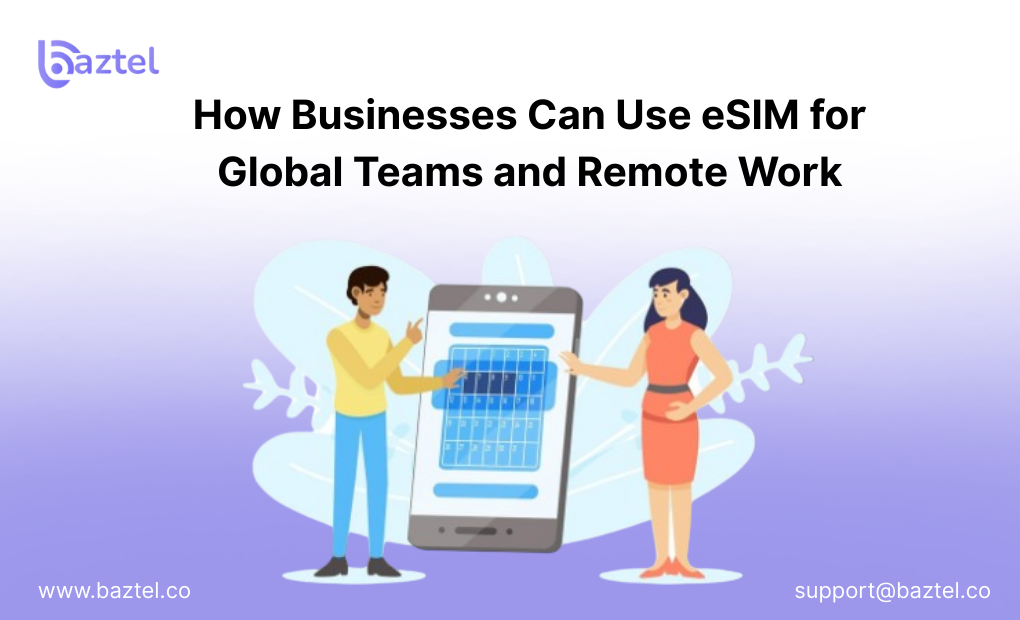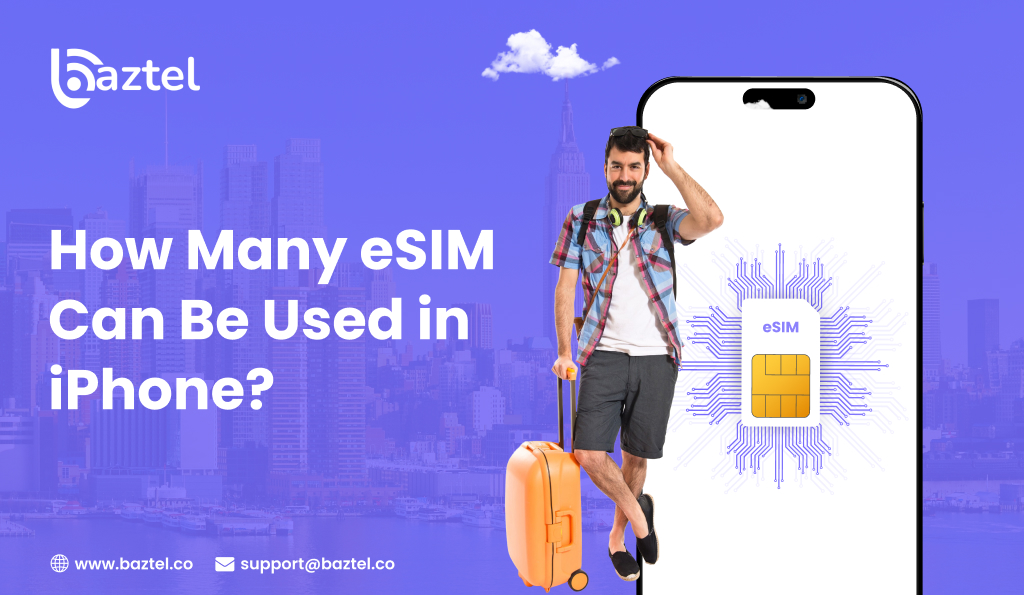Global teams are now the new normal. Whether it’s a designer working from Bali or a sales rep flying between New York and London, businesses today must stay connected across borders. But managing international SIM cards, expensive roaming bills, or delays in activation can slow things down.
That’s where eSIM for business comes in. With eSIMs, you don’t need to wait for a physical card. Just scan a QR code, and you’re live. It’s quicker, cheaper, and much more flexible than the old system. In this blog, we’ll show how eSIM for global teams solves real problems for remote businesses.
Let’s break it down with easy examples and links you can trust.
Understanding eSIM and How Does It Work
eSIM technology allows for the SIM functionality of your phone to be embedded right onto the device. No more physical chips to replace. Instead of a physical card, you activate your plan by scanning a QR or entering a code given to you by your carrier. Now changing plans, networks, or even countries can happen electronically, without swapping the hardware inside the phone.
Unlike a standard SIM card which usually requires physical handling, eSIM’s allow for remote activation. That means you can get your team members connected to your corporate plan before they have even left their home country. Works with most modern phones, tablets, and some laptops. Once companies begin to think about how they manage a globally distributed team, it can eradicate the headaches of travel and connection.
Why eSIM is Gaining Popularity in Global Business
Many businesses today have employees that work remotely or distribute across multiple countries. There is no way traditional SIM cards can offer any level of flexibility like this. Each time a team member travels internationally, they either incur high roaming charges or are losing precious time buying local SIM’s that wastes time while traveling. This all affects productivity, budgets, and communication.
eSIM for business solves this. It lets employees access local data plans in different regions without changing their phone numbers. You can manage multiple plans on a single device. Companies can distribute plans digitally without shipping physical SIMs.
There is also a factor of the use of IoT, and that many employees operate in mobile-first ways of working. eSIM also fits seamlessly into the tech ecosystems of the future. Once you have onboarded a remote hire, or set up an international sales team, eSIM enables you to have them connected and ready to work – with no time wasted.
Benefits of Using eSIM for Remote Work
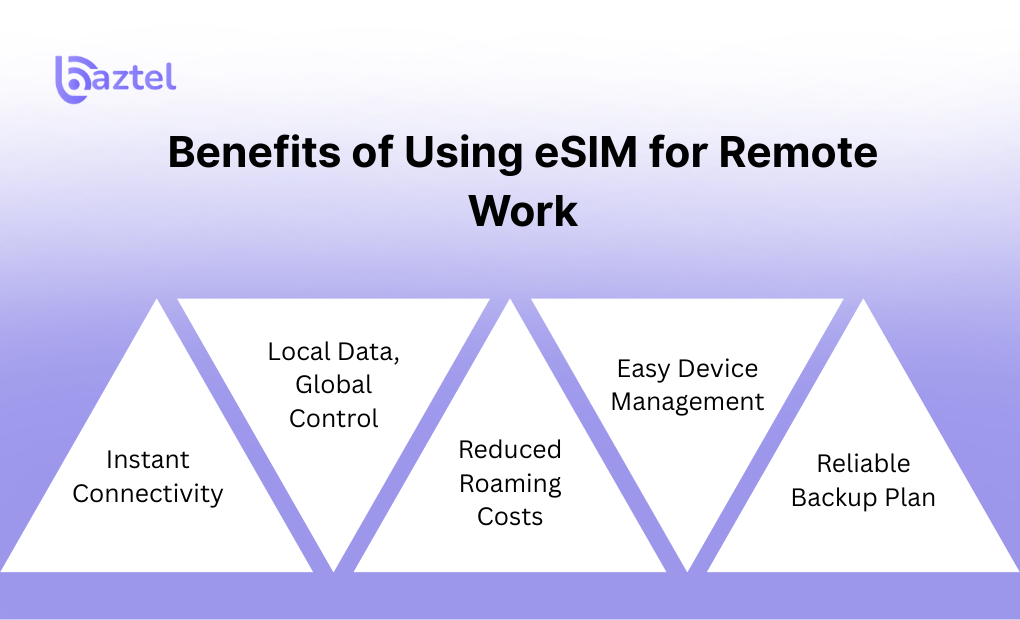
eSIM simplifies remote work in the 21st century in a variety of ways that make work smoother and more consistent. Team members are able to connect anywhere in the world, without needing a local SIM, or hunting for Wi-Fi. Remote employees save time that would otherwise be lost in delays and costs on roaming charges or travel SIM. With an eSIM there’s no waiting for a delivery— all you need to do is scan a QR Code and you are up and running. Companies can manage team connectivity from a single dashboard and see usage in real-time. My eSIM, for example, greatly improves corporate security because eSIMs cannot be removed or exchanged with another SIM. For remote workers, it means less technology trouble and more time actually getting work done, no matter where their job takes them.
Instant Connectivity
Remote employees already run the risk of delays when waiting for a physical SIM or to access Wi-Fi. eSIM allows them to activate a plan in 5 minutes or less. This can be a live-saver for last minute deployments and urgent situations.
Local Data, Global Control
Even if you have team members spread across multiple continents, you can manage all your group’s mobile plans from one dashboard. There are a number of eSIM providers that have business portals designed to help organize and manage plans, track usage, and change providers remotely.
Reduced Roaming Costs
eSIM allows team members to use local data plans, rather than pay high roaming charges. It saves money, especially for employees who travel constantly for business.
Easy Device Management
Companies can preconfigure devices with an eSIM plan. The phone the remote employee receives is already connected. This makes the new hire start their onboarding process quicker and there’s a less load on IT support.
Reliable Backup Plan
Even if a team member’s primary network goes down, you can easily add a back up plan using eSIM. This allows team members to get back to work with minimal downtime.
How eSIM Helps Businesses Scale Globally
When a business wants to enter a new country, there are many hurdles: roaming costs, network issues, delayed SIM delivery, and local support for employees. An eSIM for business helps solve all of these. It lets teams activate plans instantly—no waiting, no physical cards. Companies can give access to global teams from anywhere, and track everything remotely. This works well for remote work too, since the setup is simple, flexible, and works across borders. Using an eSIM for global teams means fewer tech headaches, stronger control, and faster go-to-market when scaling operations in new regions.
With eSIM for global teams, you can:
- Provide immediate local connectivity
- Avoid dealing with multiple physical telecom vendors
- Offer centralized management for SIM plans
- Improve data security through encrypted, remote provisioning
This removes a lot of friction from international operations and allows businesses to expand faster.
Use Cases of eSIM in Business Environments
There are many real-life ways a company can use eSIM for business. For example, a logistics firm can keep truck drivers connected across borders without worrying about SIM swaps. A software company with remote teams in India, Europe, and the US can assign region-specific data plans through a central dashboard. Sales reps travelling for demos can avoid roaming bills by using eSIM for remote work. IoT devices used in agriculture or healthcare can be managed remotely using eSIM profiles. Using eSIM for staff, travel or devices simplifies operations and makes global teams quicker, easier and more reliable than before.
For International Sales Teams
Sales reps often travel all over a region too. It is time consuming for both the business and the rep to manage multiple SIM cards or rely on local Wi-Fi. With eSIM, they just switch to a local data plan on arrival.
For Remote Developers
IT and software teams working from different time zones need uninterrupted internet. eSIM gives them stable, region-specific data access. This helps with cloud access, deployments, and remote server tasks.
For Logistics and On-Ground Teams
Field workers, delivery agents, and logistics teams benefit from eSIM by staying online throughout the day. Companies can ensure better tracking, reporting, and support.
For Customer Support Staff
Remote support teams need reliable voice and data. With eSIM, you eliminate the need for a SIM card altogether, and can ensure connectivity in areas with weak Wi-Fi infrastructure.
Is eSIM Safe for Business Use?
Adopting new technology means checking off a lot of concerns, and for businesses that have sensitive information, security is paramount. Luckily, eSIM for business is a more secure option than physical SIM cards. Since there is no physical card to swap, the risks of stealing, tampering and SIM cloning is minimised and all network credentials are held securely on a chip (which can only be accessed through certain authentications). For remote teams or global employees, this adds peace of mind. With remote provisioning and carrier lock features, eSIM for global teams makes device and data security easier to manage.
Here’s why:
- eSIM profiles are encrypted and protected by strong authentication protocols
- There is no risk of SIM swap fraud since the chip cannot be removed
- Businesses can remotely lock or wipe profiles in case of theft or misuse
- eSIM activation requires verification and carrier-side approval
How to Set Up eSIM for Your Team
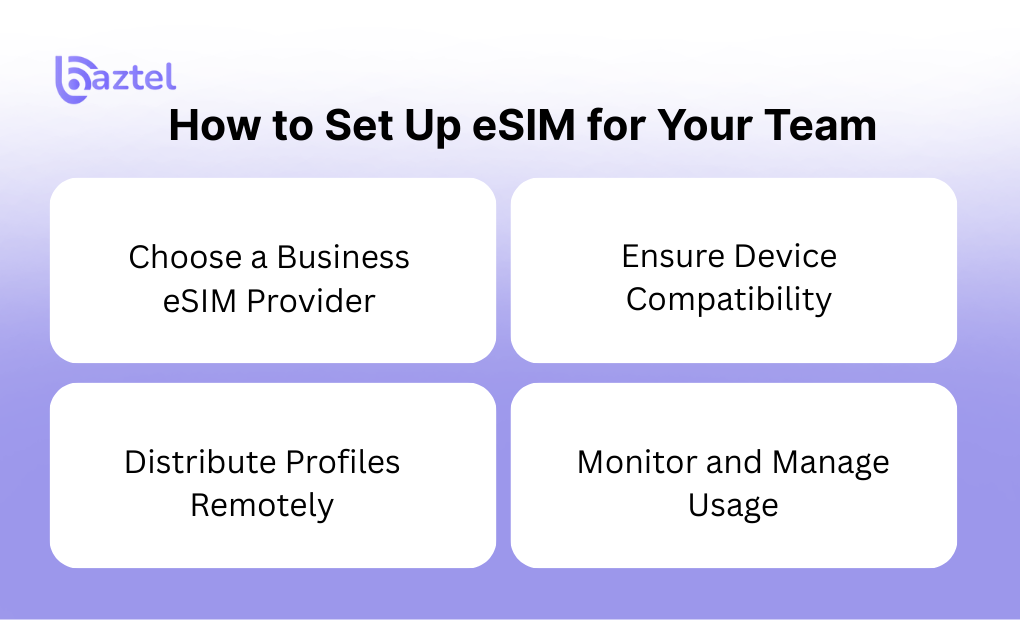
Setting up eSIM for remote work is easier than you might think. Start by choosing an eSIM provider that supports your target countries and offers business features like bulk provisioning or remote management. Most eSIMs can be installed by scanning a QR code or entering activation details manually. This makes deployment fast, even for global teams. You can pre-install eSIMs before shipping devices or send credentials to remote employees. No need to wait for SIM cards or coordinate with local carriers. For any business expanding globally, eSIM for business simplifies the onboarding of new hires across borders.
Choose a Business eSIM Provider
Look for providers that offer dedicated portals for business users. Compare coverage, pricing, and customer support. Baztel offers plans suited for remote teams and global businesses.
Ensure Device Compatibility
Most modern phones (iPhone XS and above, Google Pixel 3+, Samsung S20+) support eSIM. Before rollout, check your team’s device models and OS versions.
Distribute Profiles Remotely
Once plans are purchased, send QR codes or activation links to team members. They can scan and install the profile in a few steps. You can also pre-install eSIM on company phones.
Monitor and Manage Usage
Use the provider’s dashboard to track data usage, add/remove plans, or switch networks. This makes it easier to manage costs and respond to performance issues.
Tools and Platforms That Support eSIM
Popular remote work tools now support eSIM-connected devices. This includes Slack, Zoom, Trello, Notion, and Jira. Whether it’s video meetings or file uploads, your team won’t face connectivity delays.
eSIM also integrates well with mobile device management (MDM) platforms like:
These tools help IT teams monitor, secure, and update eSIM-enabled phones remotely.
Comparing eSIM with Traditional SIM Cards
Traditional SIM cards require physical handling, local delivery, and manual swapping—especially when teams travel. In contrast, eSIM for business eliminates these steps. With eSIM, your team can switch carriers or plans without touching the phone. It saves time, reduces human error, and avoids delays. eSIM for remote work is ideal for teams working from different regions, as it removes the need to carry multiple SIMs. It’s also more secure and harder to tamper with. If your company wants better flexibility, eSIM for global teams is a smarter and more future-proof choice than old-school SIM cards.
| Feature | Traditional SIM | eSIM |
| Physical Handling | Required | Not Required |
| Multi-network Support | One SIM per network | Multiple profiles |
| Remote Provisioning | No | Yes |
| Swapping Time | Manual change needed | Instant switching |
| Risk of Loss | High | Very low |
Switching to eSIM simplifies logistics and offers a better user experience, especially for remote-first companies.
Top Countries Where eSIM Works Well for Business
Many countries now support eSIM for global teams, making remote work smoother than ever. Popular business hubs like the United States, United Kingdom, Germany, Singapore, and Australia offer strong eSIM coverage with top telecom providers. These countries allow easy activation, flexible plans, and fast data access—perfect for growing businesses. Whether your team is attending events, working from different time zones, or launching projects abroad, eSIM for business helps avoid roaming delays and setup issues. With fewer physical SIM problems and wide availability, these regions are ideal for companies using eSIM for remote work.
Some regions have strong eSIM adoption. Businesses can easily activate plans in:
Coverage is expanding. To see country-specific guides, check our eSIM travel plans.
How to Convert Existing SIMs to eSIM for Business
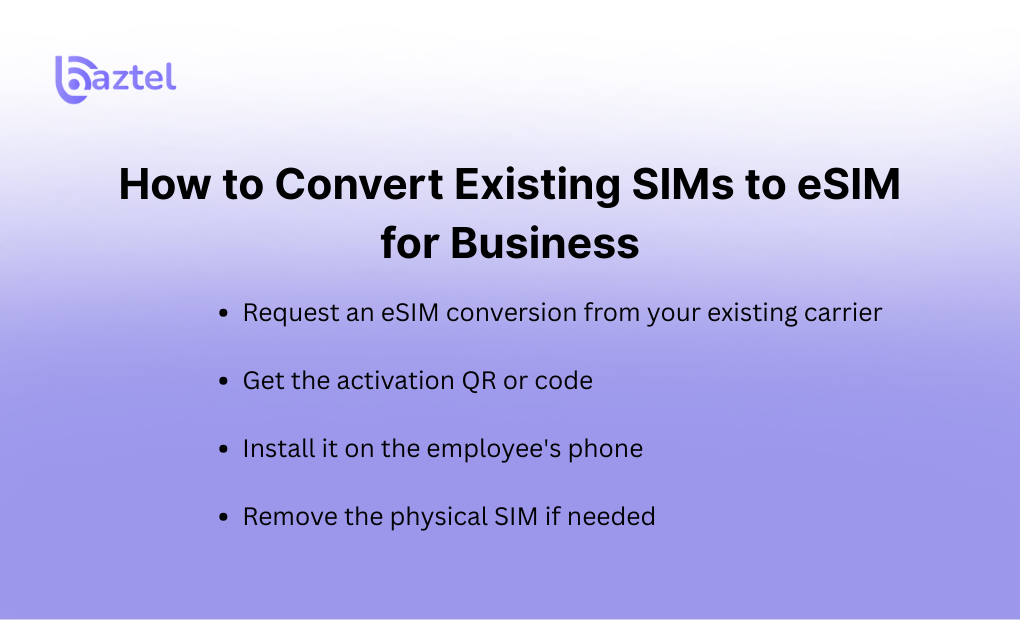
To shift from physical SIMs to eSIM, businesses need a plan that fits remote and global operations. Start by checking which employee devices support eSIM for business. Then, reach out to your carrier for a bulk switch request. Most telecom providers now allow number porting from SIM to eSIM through their app or dashboard. For global teams, this eliminates the delays of courier SIMs across borders. Once verified, your team can scan a QR code or enter the activation code to start using eSIM for remote work right away—no shipping, no paperwork, no downtime. Many telecom operators now allow number porting from SIM to eSIM. Here’s what to do:
- Request an eSIM conversion from your existing carrier
- Get the activation QR or code
- Install it on the employee’s phone
- Remove the physical SIM if needed
This way, you retain your old number and shift to the new format without disruption.
To check if your phone supports eSIM, follow our compatibility checklist.
Final Thoughts
eSIM technology is changing the way businesses think about connectivity. For remote work, global teams, and cross-border projects, it offers unmatched ease and control.
As more companies go remote-first or expand internationally, switching to eSIM is not just smart – it is strategic. From cost savings to speed, from security to scalability, eSIM helps you build a connected, flexible, and future-ready team.
If you’re looking to try it for your business, start with a small batch of remote employees. Track the usage, test the provider, and then roll it out across regions. The benefits will speak for themselves.
For more help, explore our other guides on how to activate eSIM or ways eSIM simplifies travel.
FAQs
1. What is an eSIM and how does it help remote teams?
An eSIM is a digital version of a SIM card that lets your phone connect to a mobile network without needing a physical SIM. For remote teams, it means they can get connected instantly, no matter where they are. There’s no need to wait for a SIM to arrive or visit a local store. This makes eSIM for remote work fast, flexible, and ideal for global companies.
2. Is eSIM secure enough for business communication?
Yes. eSIM for business offers strong protection. Unlike regular SIM cards, it’s built into the phone, so it cannot be removed or tampered with easily. Plus, activation is usually tied to user verification, which adds an extra layer of safety. This is helpful for companies handling sensitive data or working across multiple locations.
3. Can eSIM work in any country where my team travels?
eSIM for global teams works in most countries, but coverage depends on the provider. Many eSIM carriers offer international plans that cover over 100 countries. Before choosing, always check which regions are supported.
4. How do I switch my team from physical SIM to eSIM?
Switching to eSIM for business is usually simple. Your team members will need phones that support eSIM. You can generate eSIM QR codes through your provider, scan them, and the plan activates right away. You don’t have to wait for shipping or manage physical logistics.
5. Can we manage multiple eSIM plans centrally for our global staff?
Yes, many eSIM platforms now offer central dashboards for businesses. These tools let you assign plans, track usage, and manage top-ups for each employee, all in one place. This makes eSIM for global teams much easier to manage than traditional SIM cards, especially when your staff is spread across countries.
Blog Author
Peter
Peter started BazTel.co to make mobile internet easier for travellers. He noticed how tough it was to find good network options while visiting new countries. That’s when he built BazTel — a place where anyone can buy eSIMs online without confusion or long steps. He believes tech should be simple and useful, not complicated. When he’s free, he likes to travel, test BazTel himself, and keep improving it based on real user problems.

 Botswana
Botswana Zambia
Zambia Congo
Congo Colombia
Colombia China mainland
China mainland Chile
Chile Chad
Chad Central African Republic
Central African Republic Canada
Canada Cameroon
Cameroon Cambodia
Cambodia Burkina Faso
Burkina Faso Bulgaria
Bulgaria Brunei Darussalam
Brunei Darussalam Brazil
Brazil Aland Islands
Aland Islands Bosnia and Herzegovina
Bosnia and Herzegovina Bolivia
Bolivia Belgium
Belgium Belarus
Belarus Bangladesh
Bangladesh Bahrain
Bahrain Azerbaijan
Azerbaijan Austria
Austria Australia
Australia Armenia
Armenia Argentina
Argentina Algeria
Algeria